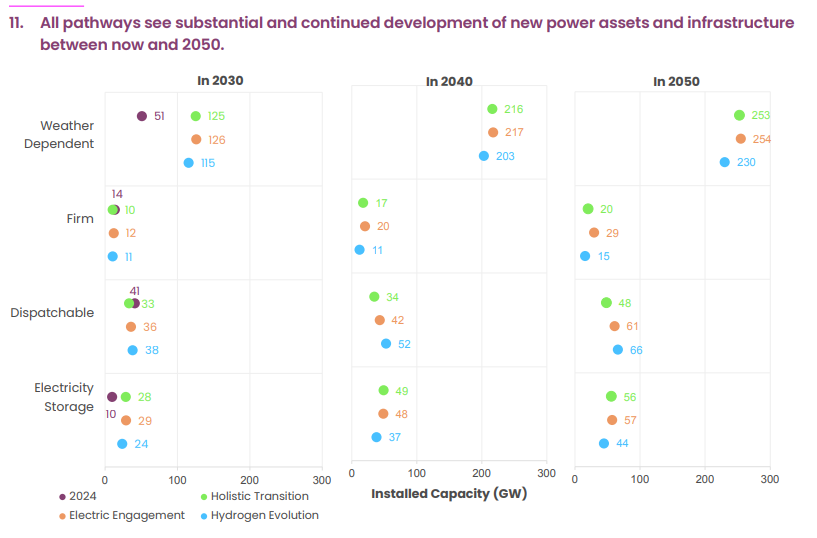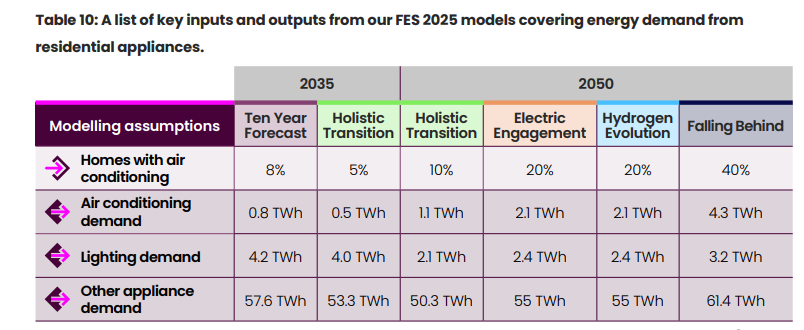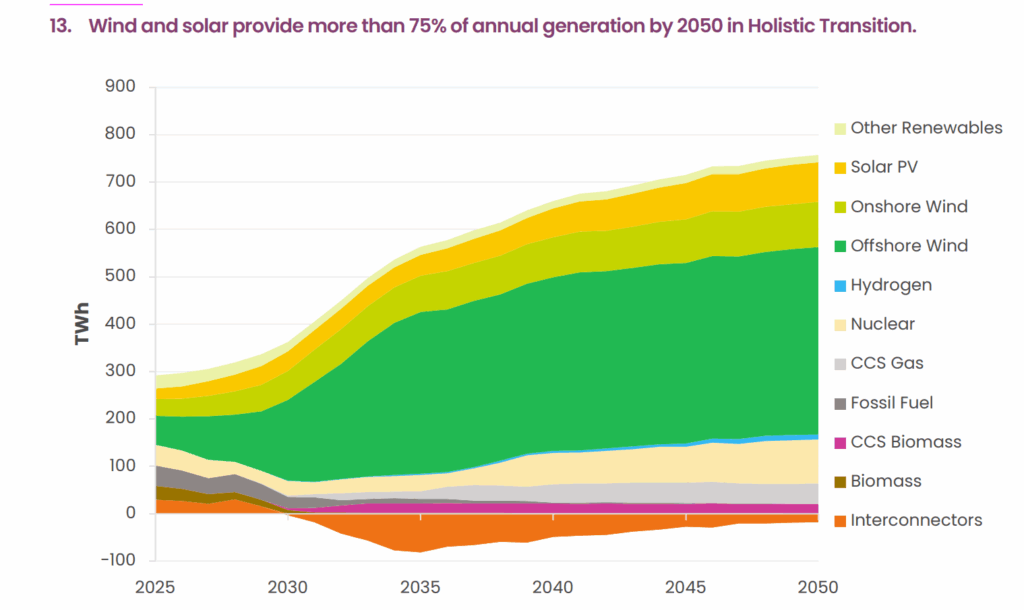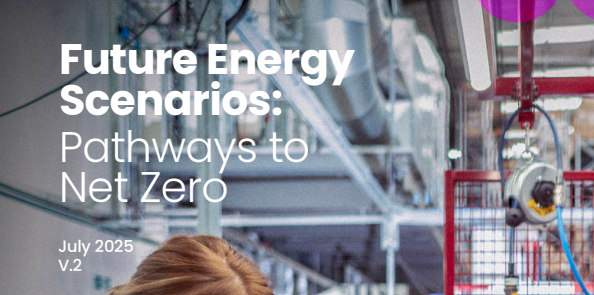The National Energy System Operator (NESO) has released its 2025 Future Energy Scenario (FES) report. They are always a good read and make you think. I have just been through and these are the things that stuck out for me, with some comments:
Political – It seems much more political in tone in the sense of emphasising government points, such as the energy transition “avoiding the roller coaster of gas and oil markets”. I suppose this is to be expected as a government owned organisation.
The Four Waves and Supply Chain Issues – The four waves they refer to as foundation, acceleration (2025-2030), growth and horizon, feel a bit forced. I am not sure there is strong underlying logic, except for how huge the impact of the Clean Power Plan 2030 is in terms of changing the structure; this 4-5year period is defined as its own wave. It got me thinking on supply chain issues. If you look at the below for power infrastructure, it shows that wind and solar (weather dependent) are going to increase from 51GW of capacity today to about 125GW in 2030. That is >15GW a year. From 2030 to 2040, there is an increase from 125GW to about 215GW, that is a deployment rate of 9GW per year. What this means is we need to increase deployment rates about 400% now and then reduce them by nearly half from the new peak. How will consultants and suppliers respond to this feast and relative famine? These numbers suggest a smoother transition might be better for all.

Electricity Prices – There is a theme throughout around assuming electricity prices are reduced by removing the environmental levies, as has been urged by the Climate Change Committee, but that is going to be very difficult. From some quick looking, it appears the levies are about £5bn a year on our electricity bills. As context, the big government rebellion recently was over cuts to welfare that would have saved us £5bn, if they had gone through. Imagine how keen a chancellor will be to add that to the general taxation! (There is a much deeper discussion about how governments of all shades have spent decades shifting costs and commitments off general taxation so they are harder to detect.) Even with the levies removed electricity prices only come down about 10% to 15%, or £150 a year. It will be helpful on people’s bills and will support electrification, but it doesn’t feel like a game changer. Using variable tariffs and being smart with your electrical use could save you a lot more. It also occurs to me is that once we have shifted the levies on to general taxation they will have to stay there and they are going to get bigger over the next few years, so even less appealing to the chancellor.
Buildings – Thermal efficiency in buildings is addressed. There is acknowledgement that we do not need high insulation levels to enable heat pumps, as has been claimed by some. I have always been an advocate of electrification and limited thermal insulation; simple measure such as draught-proofing and loft insulation are great, but to get big heat demand reduction gets unjustifiably expensive very quickly. There seems to be an acceptance of that slowly filtering through as “fabric first” gets mentioned less by government, generally. The main benefit of insulation may be on peak demand and not so much around overall efficiency. The big challenge in ten years will be that two week period in February when it is very cold and there is no wind. It is right then that fabric insulation will be able to reduce peak demand. It would be interesting to see a study on this in terms of how much difference it can make cost-effectively. It definitely won’t justify widespread deep retrofit, but it will help the case for fabric.
On the theme of home heating, the FES scenarios all seem to assume around 20% of homes connected to a heat network in 2050, whilst the government’s consultation earlier in the year on heat network zoning, suggests a maximum of 11% of homes will be more cost-effectively heated through a heat network than individually. I am not sure what difference it makes to the FES energy pathways, but it is a big discrepancy and seems like FES is working on outdated assumptions. You wonder what other numbers need significant updates.
Air conditioning / comfort cooling has been on my mind a lot recently. I am an advocate of increasing its deployment and use, albeit carefully, to improve people’s quality of life and reduce ill health from overheating. What I found interesting is that the increase in air conditioning is greatest in the “falling behind” pathway/scenario, with 40%. From one perspective, it makes sense; more air conditioning = more energy use, but I fear it reinforces the narrative that taking greater comfort and having better lives with additional energy is a bad thing. I hope and expect that most homes will have cooling by 2050, carefully controlled. By 2050, electricity generation will so abundant and cheap we will be thinking about what wonderful things can be done with it, it is just the transition we need to get through.

Hydrogen – The numbers on hydrogen surprised me, with a vision for 2050 where there is at least 100TWh of hydrogen production. NESO emphasise the need for urgent guidance from the government on the big picture for natural gas and hydrogen so the sector can prepare. With a lot of understatement, they say, “Plans to connect large assets to gas today will have long-term impacts on the future needs of gas networks….” I agree with the request, but I expect the government will continue to be studiously vague, hoping that industry and the public will come to their own conclusions on heating and transport before they say anything formally. Despite the suggested neutrality, NESO’s central scenario assumes almost no use of hydrogen in home heating. There is a consultation due on hydrogen in home heating, so that may help as a trigger for the big conversation.
Electric and Autonomous Vehicles – Electric vehicles offering up to 51GW of flexible demand by 2050 is interesting. I agree with the assumption that cars can play a huge role in our demand flexibility. (My quick maths is that once we have electrified just cars that is about 1.5TWh of energy storage.) But the FES, as with so many policy documents, expects autonomous vehicles to come, but doesn’t then follow the logic of where that takes you; in all their scenarios there are over 30 million vehicles on the road in 2050, about the same number as now. Studies looking at requirements when the fleet is autonomous normally estimate a reduction of 80% to 90%. In that case, there would only be about 5 million vehicles on the road. It would be interesting to see their maths with a fleet that size.
Data centre demand is predicted to be between 30 and 71TWh in 2050, from a current 7.6 TWh today. Although the FES notes the uncertainty, I am surprised at the narrowness of the range. From what I am reading, the range goes from a modest increase only as processing breakthroughs cut power demand per unit of processing all the way to data processing being the dominant electricity use on earth. Still, even if I am too uninformed to comment, looking back at earlier FES reports shows how things can change; FES 2022 predicted the maximum electricity use from data centres in 2050 would be 20TWh. That estimate is 350% what it was 3 years ago.
Interconnectors and the Blind Spot – Interconnectors are predicted to have a significant but small role with steady growth predicted up to around 20GW. You can see below in the graph we are predicted to be a net exporter of electricity from 2030. There is no discussion of large scale import of electricity from places where solar is much cheaper. We have a blind spot to the solar revolution coming. I think this will change in the next few years and it occurs to me the snap in perception is going to need to be the first large scale project. I am not sure where Xlinks are now as they aren’t being offered a CfD, but I hope we can see something like that come to fruition soon. It is a political hot potato, but it is inevitable and wonderful.

Those were my main thoughts reading it. It is going to be an exciting few years for the FES, as the annual rate of change on the demand, generation and balancing aspects is going to be rapid.


Leave a Reply